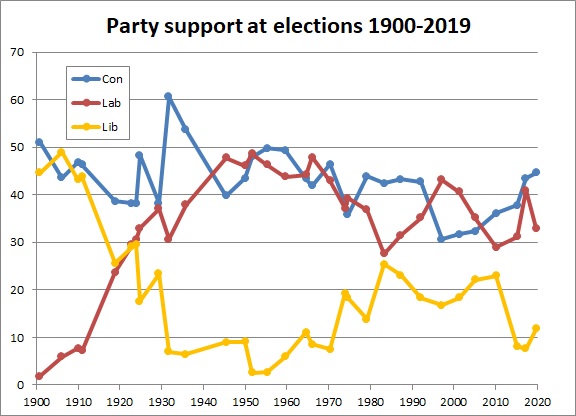The local elections showed that the Conservatives gained strongly and all the other main parties are lost ground. Ignoring opinion polls for a moment, the local elections results suggest a Conservative majority of around 120 seats, with Labour reduced to about 190 seats, their lowest count since 1935.
That's based on taking the Projected National Vote share form the local elections and correcting for the historic difference between local and general elections.
And the opinion polls and betting markets both show a similar story. They predict that the Conservatives will get around 400 seats.
Let's assume, for a moment, that the general election turns out in line with all these predictions. The Conservatives get a big majority, Labour is further depleted, and the other nationwide parties win few seats.
That's a pretty happy ending from a Conservative point-of-view. But what about the other parties. What do they do next?
Labour has perhaps the worst problem. They appear to be in long-term decline. Many people ask what is the point of the Labour party. Its original purpose was to fight for the rights of the working class. But that has faded away both as the working class has shrunk and their rights have been entrenched. Now Labour could decay slowly away like the Liberal party did in the early twentieth century. Maybe it deserves to die. But what replaces it? Who can feast on the Labour corpse?

One possibility was UKIP. The smart move for UKIP would have been to position themselves as the left-wing nationalist party of the populist working class. They should have moved leftwards, and moderated their relatively extreme nationalism. Then they might have picked up a lot of Labour support outside London and Wales. But they haven't executed that strategy. Their Conservative-inclined supporters have gone back to the Conservatives, and there is little sign of growth from disaffected Labour voters. They have slipped back into fourth place behind the Lib Dems nationally. Indeed, UKIP too may be fatally injured.
The other parties, the Liberal Democrats and the Greens, are light years away from being even the official opposition at Westminster, never mind being the government.
But Nature abhors a political vacuum. Who will be the opposition to the Conservatives?
Although it's the hoariest of political chestnuts, perhaps the time has finally come for a realignment of the non-Conservative parties. It may be the least unlikely of the possible options.
In original work commissioned by the Constitution Society, Electoral Calculus has looked at how this could work in practice.
Although all options are necessarily messy, one plausible scenario is a split of the Labour party into its moderate and left-wing parts. The moderates would then have to unite with some or all of the Lib Dems and Greens to form a new entity. The process would not be easy for any participant, but the alternative is near-perpetual Conservative hegemony and a literally useless opposition.
Let's give this new party the working title of the Progressive Party, as that is a common word used to describe non-Conservative/UKIP forces.
The electoral arithmetic makes it difficult for the Progressives to win a general election, even in 2022, but it could become the official opposition. To do that requires three things: for around 30pc-40pc of Labour MPs and supporters to join the Progressives; for most Lib Dems and Greens to also join; and for the Progressives together to gain about 5pc in the polls.
| Switch share | |||||
|---|---|---|---|---|---|
| Gain | 20% | 30% | 40% | 50% | 60% |
| -5% | Third | Third | Third | Third | Third |
| 0% | Third | Third | Opposition | Opposition | Opposition |
| 5% | Third | Opposition | Opposition | Opposition | Opposition |
| 10% | Opposition | Opposition | Opposition | Opposition | Opposition |
| 15% | Opposition | Opposition | Opposition | Government | Government |
| 20% | Opposition | Government | Government | Government | Government |
The table shows where the Progressives would come in Parliament (third-largest party, official opposition, or government) depending on various scenarios. The scenarios are driven by two parameters. The first, called "Switch share", is the fraction of Labour MPs and supporters who switch to the Progressives. Possibilities are shown from 20pc (one fifth of Labour supporters switch) to 60pc (three fifths switch). The second, called "Gain", is the change of support for the new party in the polls. The Progressives would hope for a bounce in the polls, though the possibilities run from -5pc (a small reduction in support) to +20pc (large gain in support).
The new Progressives can become the official opposition with only 30pc of existing Labour supporters and MPs, plus a 5pc bounce in the polls. That is well within the bounds of possibility for 2022. This is not political science-fiction, but a clear and achievable objective.
And this isn't some doomed repeat of the SDP in the 1980s. The SDP only attracted 28 Labour MPs out of 268, or about 10pc. The Progressives need to aim much higher than that. But with 172 Labour MPs voting no confidence in Jeremy Corbyn a year ago, gathering 70 of them for a new path looks practicable.
After that they have to fight the Conservatives head-to-head as oppositions are expected to.